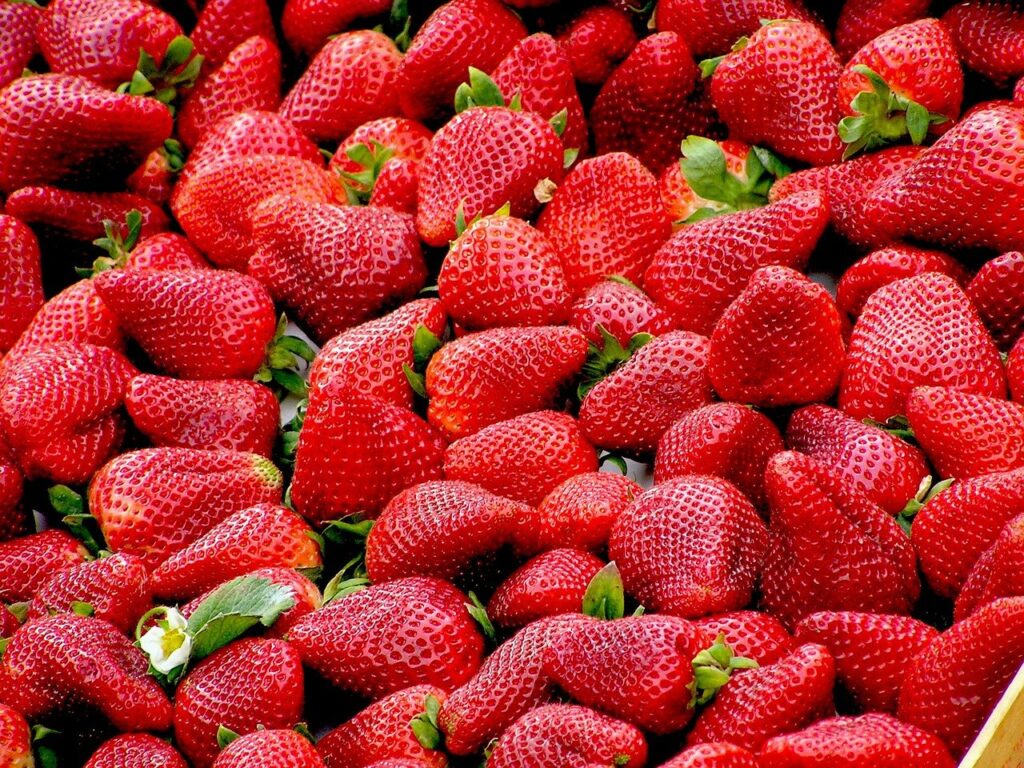Who doesn’t like strawberries!? And what a delight to wake up in the morning to pick a handful of your very own fruit to eat with your breakfast.
It’s an experience for all of our senses. You search for that perfect berry – bright, red, shining like a jewel. You hear the satisfying snap as you pull the strawberry from the vine that lets you know you’ve picked the berry at its peak. Already you can smell the sweetness from the little sun-warmed berry in your hand. And finally, you pop the ruby prize into your mouth, biting down and savoring the candy-like juices of the berry.
Leave behind the guilt of yet another plastic packaging tray and embrace the joy of growing your own produce with these tips and tricks for growing your own strawberries at home.
Nutrition facts

Strawberries mainly consist of water (91%) and carbohydrates (7.7%). They contain only minor amounts of fat (0.3%) and protein (0.7%).
The nutrients in 3.5 ounces (100 grams) of raw strawberries (3Trusted Source) are:
- Calories: 32
- Water: 91%
- Protein: 0.7 grams
- Carbs: 7.7 grams
- Sugar: 4.9 grams
- Fiber: 2 grams
- Fat: 0.3 grams
Strawberry plants come in three types:
- June-bearing varieties bear fruit all at once, usually over a period of three weeks. Day-length sensitive, these varieties produce buds in the autumn, flowers, and fruits the following June, and runners during the long days of summer. Although called “June-bearing” or “June-bearers,” these strawberries bear earlier than June in warmer climates.
- Everbearing varieties produce a big crop in spring, produce lightly in the summer, and then bear another crop in late summer/fall. These varieties form buds during the long days of summer and the short days of autumn. The summer-formed buds flower and fruit in autumn, and the autumn-formed buds fruit the following spring.
- Day-Neutral varieties produce fruit continuously through the season, until the first frost: Insensitive to day length, these varieties produce buds, fruits, and runners continuously if temperature remains between 35° and 85°F (1° to 30°C). Production is less than that of June-bearers.
For the home garden, we recommend June-bearers. Although you will have to wait a year for fruit harvesting, it will be well worth it.
Below we share with you our top 6 secrets for getting the tastiest strawberries from your garden.
1. Prune after fruiting
After fruiting has finished, tidy up your plants by giving them a hard prune. Use secateurs to snip of a majority of the leaves. Some people even use their lawn mower to do this!
2. Provide plenty of sunlight
Find a sunny location for your plants. The heat and light will help produce sweet and flavoursome fruit.
3. Prepare a fertile and well-drained soil
To help your soil drain try mounding your planting beds or if you are planting in a container choose a premium potting mix and ensure your container has at least one drainage hole. Strawberries like a slightly acidic soil of around 6 to 6.5. Ideally about a month before planting dig in plenty of compost and well-rotted animal manure. Water fortnightly with seaweed solution to improve the vigor of your plants.
4. Give them space
Plant around 30 centimetres apart and remove at least some of the runners growing out from your original plants otherwise your strawberry bed with get overcrowded. This will make your plants less productive and your fruit smaller and sour. The runners are usually produced over summer and can be used to propagate new plants if you wish.
5. Water well but keep leaves dry
Keep plants well-watered, especially when they are settling in, during dry summers and when fruiting but try to avoid watering the leaves. Instead water the soil at the base of the plant.
6. Mulch around each plant
Keep your plant beds well mulched to retain moisture, control weeds and prevent your fruit from contacting the soil. Some straw will do the trick, hence the name “straw” berry.
Leave a reply













